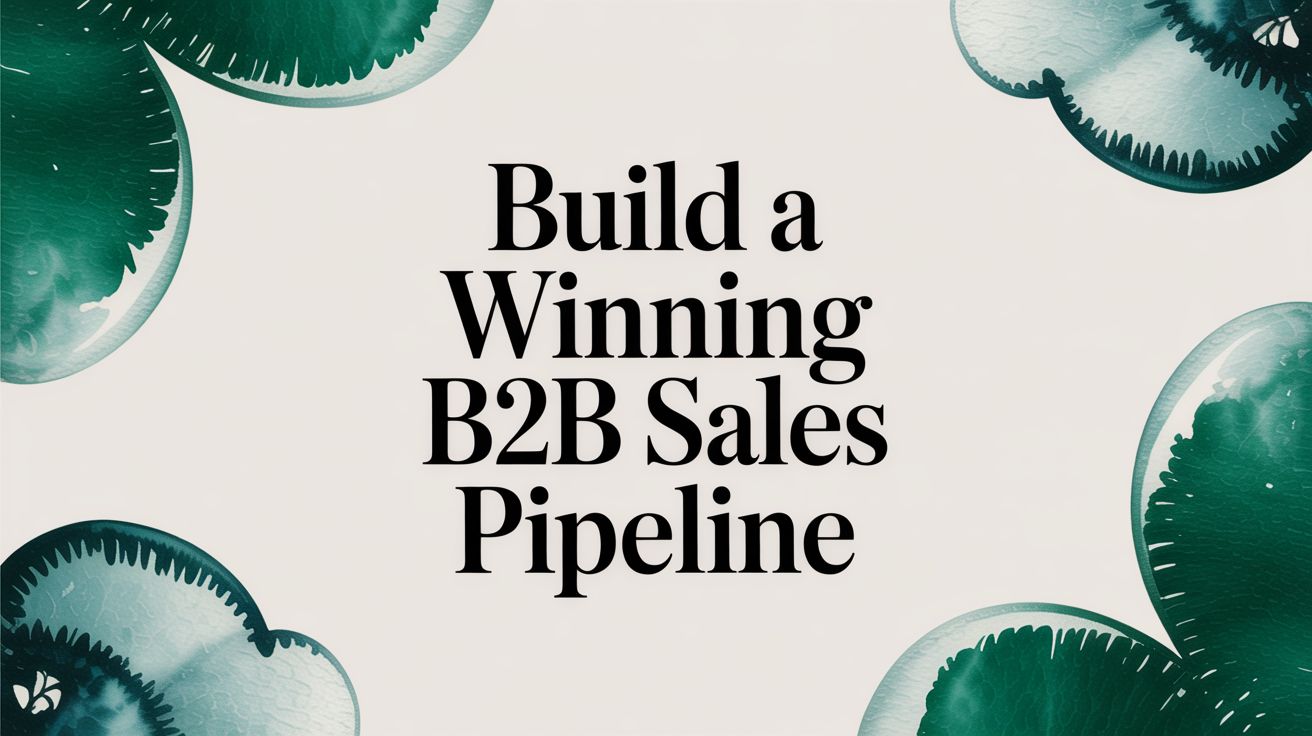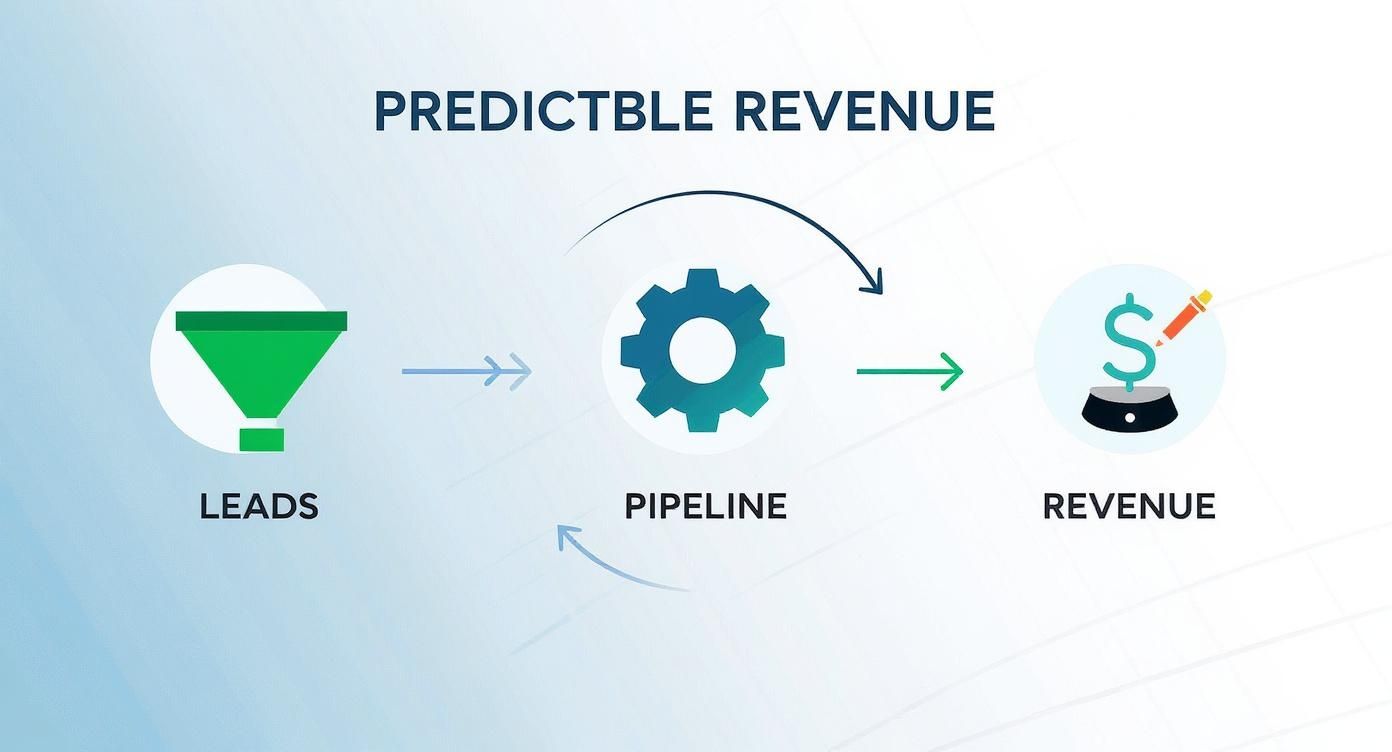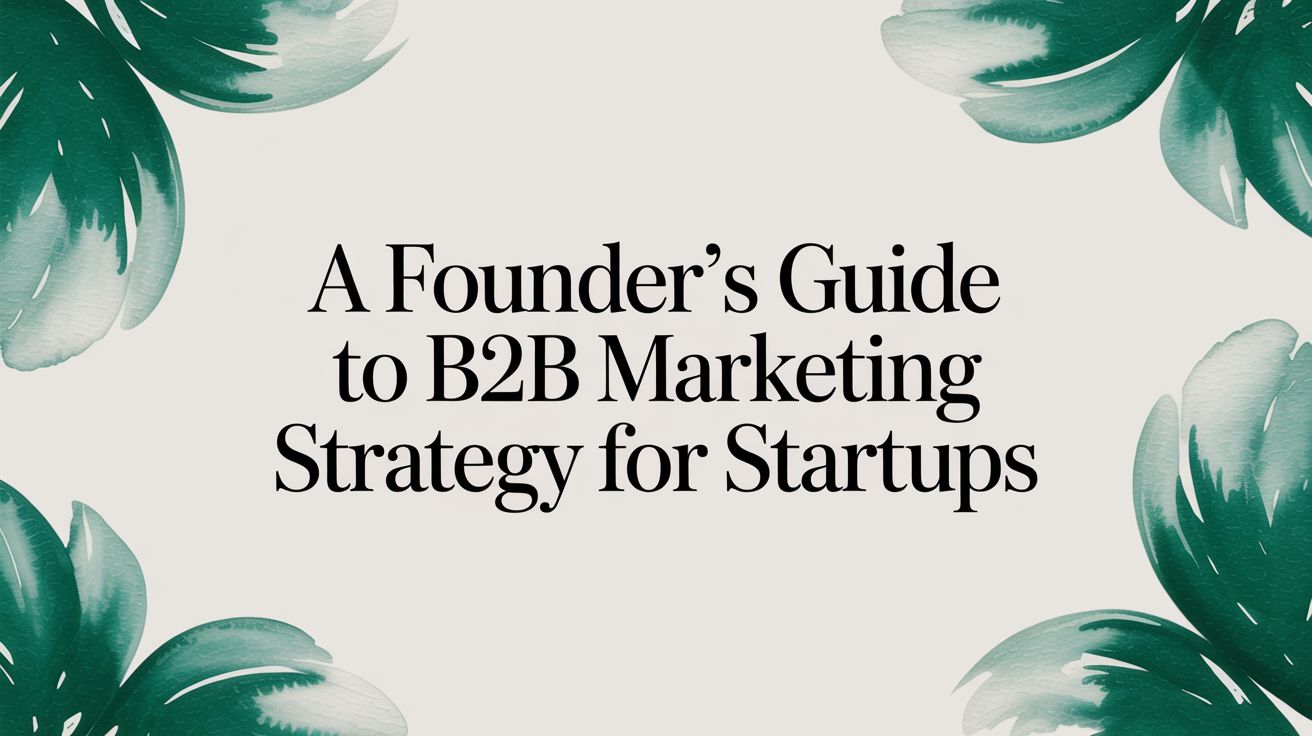Build a Winning B2B Sales Pipeline
November 2, 2025

Imagine your sales process not as a jumble of random calls and emails, but as a finely tuned engine. An engine that methodically turns prospects into paying customers with predictable precision. That's what a mastered B2B sales pipeline gives you. This guide is your blueprint for building that engine, one designed specifically to deliver reliable revenue growth for your B2B organization.
Your Blueprint for Predictable Revenue Growth
Think of your B2B sales pipeline as an assembly line for your deals. It’s a visual, step-by-step process that tracks every single opportunity as it moves through a set of defined stages—from that first flicker of interest all the way to a signed contract.
This is different from a sales funnel, which is more of a marketing concept showing how a large number of potential buyers dwindles over time. A pipeline, on the other hand, represents the concrete actions your sales team takes to actively push qualified deals forward.
By giving every deal a clear path to follow, you transform sales from an unpredictable art form into a repeatable science. You can finally forecast revenue with confidence, spot bottlenecks before they wreck your quarter, and coach your team with surgical precision. It's the key to getting a real grip on your company's growth.
The Foundation of Scalable Sales
A well-defined pipeline gives you an honest, objective look at the health of your business. It shifts conversations away from "gut feelings" and toward data-backed strategy. Instead of just wondering why deals are stalling, you can see the exact stage where they’re getting stuck.
To really get how this works, you need to understand the mechanics behind it. This means digging into what is sales pipeline management and the principles that make it effective. It's the foundational knowledge you need to build a system that actually works.
A structured pipeline gives your team:
- Clarity: Everyone knows the exact steps needed to move a deal to the next stage. No guesswork.
- Accountability: Reps take full ownership of their deals and their progress.
- Efficiency: Your team's energy is spent on deals that have a real shot at closing, not wasted on unqualified leads.
A pipeline isn’t just a fancy to-do list. It's a dynamic map of your future revenue. It shows you exactly where you are, where you're headed, and the route you need to take to get there.
Moving from Chaos to Control
Without a formal B2B sales pipeline, most organizations operate in reactive chaos. Every salesperson has their own unique process, forecasting is a shot in the dark, and it’s nearly impossible to figure out what's working and what’s not.
Putting a pipeline in place is the first real step toward building a sales organization that can scale. It allows you to build a machine where you can feed qualified leads in one end and get a predictable stream of closed deals out the other. This guide will show you exactly how to build that machine, piece by piece.
Deconstructing the Modern B2B Sales Pipeline Stages
A powerful B2B sales pipeline isn't just some vague concept; it's a structured journey with clear signposts. Think of it as a roadmap that guides your team and a prospect from that first "hello" all the way to a signed contract.
Without this map, your sales team is basically driving in the dark. They end up wasting precious time and energy chasing deals that were never going anywhere in the first place.
Visualizing this process makes it crystal clear how potential leads are methodically turned into predictable revenue.

This flow really gets to the heart of what a pipeline does: it’s an engine that converts a list of potential leads into a managed set of real opportunities, which ultimately spits out revenue.
So, let's break down the individual stages that make this conversion engine tick.
Stage 1: Prospecting and Lead Generation
This is the very top of your pipeline—where it all begins. Prospecting is the hands-on work of finding potential customers who match your Ideal Customer Profile (ICP). It's about building a solid list of companies and contacts who have the exact problems your solution was built to solve.
Key activities here are things like cold outreach, responding to inbound inquiries from your website, and networking within your target industry. The goal is simple: start a conversation and spark some initial interest. A lead officially enters this stage the moment that first contact is made or they fill out a form.
Stage 2: Qualification
Here’s a hard truth: not every prospect is a good fit. This stage is where you separate the real contenders from the pretenders. Qualification is a crucial filter that protects your sales team's most valuable asset—their time—by making sure they only focus on opportunities with a real shot at closing.
Pushing a poorly qualified lead down the pipeline is a recipe for disaster. It just creates a stalled deal that clogs things up later. The most common framework for this is BANT:
- Budget: Does the prospect actually have the money to buy your solution?
- Authority: Are you talking to the person who can make the final call?
- Need: Is there a clear, painful business problem that your product directly solves?
- Timeline: Do they have a specific timeframe for finding a solution?
An opportunity only graduates from the Qualification stage once you can confidently answer "yes" to these fundamental questions. This discipline prevents your pipeline from becoming bloated with low-quality deals that will never close.
Stage 3: Discovery and Needs Analysis
Once a lead is qualified, it's time to go deep. The discovery stage is less about pitching and more about listening. Your primary goal is to completely understand the prospect's challenges, their current way of doing things, and the specific results they're trying to achieve.
This is where you ask the smart, probing questions to uncover the true scope of their problem and even quantify the negative impact it's having on their business. The exit criteria for this stage is a mutual agreement that a significant problem exists and your solution looks like a potential fit. This shift from a general need to a specific, understood pain point is a critical step in the overall B2B sales cycle.
Stage 4: Demonstration and Solution Presentation
Armed with a deep understanding of the prospect's needs, you can now show them your solution. But this isn't about rattling off a list of features. It's about presenting your product as the direct answer to their problems.
A great demo tells a story where the prospect is the hero, and your product is the tool that helps them overcome their challenges. This stage needs to be highly customized. You should only focus on the parts of your product that solve the specific pain points you uncovered during discovery. The goal is to get the prospect to say, "I can see how this would work for us."
Stage 5: Proposal and Negotiation
After a successful demo, the prospect should be sold on the value. Now, it's time to make it official. This stage involves sending a detailed proposal that outlines the scope of the solution, pricing, implementation timeline, and the terms of the agreement.
Some negotiation might follow, usually focused on fine-tuning details like pricing or contract terms. A deal officially moves out of this stage when the prospect gives you a verbal or written confirmation that they're ready to move forward.
Stage 6: Closing the Deal
This is it—the final step. Getting the contract signed and welcoming a new customer into the fold. The closing stage involves finalizing all the paperwork, handling any legal reviews, and officially onboarding the new client.
Once the contract is signed and the payment is processed, the deal is marked "Closed-Won."
It's also important to remember that the modern buyer's journey is happening online. By 2025, it's estimated that a whopping 80% of B2B sales interactions will occur in digital channels. This massive shift means you need a pipeline that supports online engagement every step of the way, from that first LinkedIn message to the final e-signature on the contract.
To bring it all together, here’s a quick-reference table summarizing the pipeline journey. It breaks down what your sales team should be aiming for, what they should be doing, and what needs to happen to move a deal to the next step.
The 6 Core Stages of a B2B Sales Pipeline
This table acts as a great cheat sheet for sales leaders and reps alike, ensuring everyone on the team is aligned on what it takes to successfully guide a customer through their buying journey.
Measuring What Matters for Pipeline Health
Without data, you're flying blind.
A B2B sales pipeline isn’t just a pretty visual for your weekly team meeting; it’s a living system that churns out mountains of data. The difference between a good sales leader and a great one is learning how to read that data to see the real story of your pipeline’s health. It’s about moving past surface-level numbers to diagnose problems with surgical precision.

This lets you make small, targeted adjustments that have a massive impact on your bottom line. Instead of guessing, you can pinpoint the exact stage where deals are getting stuck or identify which reps need a bit of extra coaching. Let’s break down the core metrics that tell you what’s really going on.
Pinpointing Bottlenecks With Stage-by-Stage Conversion Rates
Your pipeline shouldn't be a straight tube where everything flows through easily. It's meant to be a filter, and stage-by-stage conversion rates measure the percentage of deals that successfully make it from one stage to the next. This is your single most powerful diagnostic tool for finding blockages.
For instance, you might see a high conversion rate from 'Qualification' to 'Discovery' but a dismal rate from 'Demo' to 'Proposal'. That’s a huge red flag. But it doesn't automatically mean your qualification process is broken.
A poor demo-to-proposal conversion rate often signals that your product demos aren't connecting the dots between your solution's value and the specific pain points you uncovered in discovery.
By tracking these rates, you can stop blaming "bad leads" and start fixing the real tactical issues in your sales process, like improving your demo skills or refining how you build proposals.
Measuring Efficiency With Average Deal Size and Sales Cycle Length
These two metrics are a classic power couple. Together, they paint a clear picture of your pipeline’s overall efficiency and profitability, answering some fundamental questions about your sales motion.
- Average Deal Size: This is the average revenue you bank from each closed-won deal. Keeping an eye on this tells you if your team is targeting the right kind of customers and if you’re getting better at upselling or cross-selling.
- Sales Cycle Length: This tracks the average time it takes for a deal to go from that very first touchpoint to a signed contract. A long or, worse, a lengthening cycle can signal friction in your process. It often means deals are stalling out because there isn't a clear next step.
The ideal scenario? Watching your average deal size climb while your sales cycle length shrinks. It means your team is closing bigger deals, faster—a surefire sign of a healthy, efficient pipeline. Of course, knowing the cost to get these customers is just as vital for profitability. To get a handle on that, check out our guide on how to calculate customer acquisition cost.
Diagnosing Speed With Pipeline Velocity
Think of Pipeline Velocity as the ultimate health score for your B2B sales pipeline. It’s the speedometer for your revenue engine, measuring how fast deals are zipping through your pipeline and how much cash you can expect to close on any given day.
The formula pulls together several key metrics we’ve discussed:
(# of Opportunities x Average Deal Size x Win Rate) / Sales Cycle Length
A higher velocity means more money is flowing through your pipeline, and it's happening faster. If your velocity starts to dip, this formula helps you diagnose precisely why. Is it because you have fewer opportunities in the pipe? Is your win rate taking a hit? Or is your sales cycle getting bogged down? This metric forces you to see the entire system, not just one number in isolation.
The global B2B e-commerce market is set to hit a staggering $36.16 trillion by 2026, showcasing the sheer scale of modern business transactions. Much of this explosion is happening in sectors like manufacturing and healthcare, where having a slick, scalable sales pipeline isn’t just a nice-to-have—it’s a necessity for grabbing market share. Discover more insights about the B2B e-commerce market on coalitiontechnologies.com.
Building a High-Performing Pipeline from the Ground Up
A great B2B sales pipeline is more than just a spreadsheet of potential deals. Think of it as a living, breathing engine for your revenue—a direct reflection of a disciplined, repeatable process that turns sporadic wins into a predictable stream of closed business.
Building this engine isn't about frantically stuffing the top of the funnel with leads. It's about careful architecture. The entire process starts not with a flurry of cold calls, but with a moment of absolute clarity.
The first, non-negotiable step is defining your Ideal Customer Profile (ICP). This isn't just a description of who can buy your product, but a detailed breakdown of the company that should buy it. Your ICP is the strict bouncer at the velvet rope of your pipeline; if a prospect doesn't match the profile, they don't get in. This discipline ensures your sales team invests its most precious resource—time—only on opportunities with a real shot at closing.
Establishing Your Sales Playbook
Once you know exactly who you're targeting, you need to map out precisely how your team will engage them. This is where a formal sales playbook comes in. It’s the instruction manual for your revenue engine, removing all the guesswork by codifying the specific actions, questions, and goals for each stage of the sale.
A solid playbook should detail:
- Entry and Exit Criteria: What absolutely must be true for a deal to move from 'Qualification' to 'Discovery'? Get specific. For example: "Confirmed BANT and scheduled a discovery call."
- Key Activities: What are the exact tasks for each stage? This could be sending a specific follow-up email sequence or using a standardized demo script.
- Essential Resources: Give your reps the tools they need to win. This means easy access to proposal templates, competitor information, and case studies relevant to each step.
A well-documented playbook is the foundation for scaling. It makes sure every single person on your team is following the same proven process, every time.
Enforcing Consistency with a CRM
A playbook is just a document until you enforce it. That's where a Customer Relationship Management (CRM) system becomes absolutely essential. Implementing a CRM from day one is how you make sure the rules you've established are actually followed. It’s the central nervous system for your entire pipeline.
Your CRM should be configured to perfectly mirror the stages you defined in your playbook. By making it mandatory for reps to log every activity and update deal stages, you create a single source of truth for all pipeline data. This simple act of discipline prevents deals from getting stuck in limbo and gives you the visibility needed to forecast accurately and coach your team effectively.
Forging a Powerful Sales and Marketing Alliance
A high-performing pipeline is rarely built by the sales team alone. It's the product of a powerful alliance between sales and marketing, with both teams marching in lockstep toward the same revenue goals. When these two teams are misaligned, it’s one of the quickest ways to starve your pipeline of quality deals.
A healthy pipeline should look like a funnel, not a tube. If you see a big bulge in the middle stages, it’s a massive red flag. It usually means one of two things: either marketing is tossing unqualified leads over the fence, or sales isn't doing its job moving them forward.
When both teams agree on the ICP and what constitutes a "sales-qualified lead," marketing can zero in on generating the right kind of interest. This partnership is the key to effective B2B lead generation, ensuring a smooth handoff and filling the top of the funnel with prospects who are actually ready for a sales conversation.
For a masterclass on finding those perfect prospects, check out the ultimate guide to building B2B lead lists using Sales Navigator. Nailing these foundational systems—a clear ICP, a documented playbook, a well-used CRM, and a united sales and marketing front—is how you construct a pipeline that doesn't just track deals, but actively drives them to a close.
Using Technology to Accelerate Your Sales Pipeline
In B2B sales today, technology isn't just a nice-to-have; it's your force multiplier. Trying to manage every lead and follow-up manually is like showing up to a Formula 1 race on a bicycle. You might be working hard, but you're going to get lapped. Smartly using modern tools is how you build an intelligent, efficient, and faster B2B sales pipeline.

This isn't about replacing your sales team. It's about augmenting their skills. It’s about automating the mind-numbing, repetitive work that drains their energy and giving them the data-backed insights needed to focus on what humans do best: building real relationships and closing complex deals. Think of it as an investment in both speed and precision.
Embracing AI for Smarter Pipeline Management
Artificial intelligence is turning the art of sales into more of a science, replacing guesswork with data-driven confidence. One of its key applications right now is lead scoring. Instead of reps manually sifting through a mountain of leads, AI systems can analyze thousands of data points in real-time to bubble the hottest prospects straight to the top.
This has a massive impact. Research shows that using AI can boost lead quality by 37% and shrink sales cycles by 28%. Why? Because your team stops wasting time on dead ends and focuses their effort where it actually counts. Better yet, AI-driven predictive lead scoring hits 43% higher accuracy, making sure your team is always working on the right opportunities first. You can dive deeper into these pipeline generation trends on salesintel.io.
Automation and Personalization at Scale
If AI is the brains of a modern pipeline, automation is the engine that drives its velocity. It takes all the manual, time-sucking tasks off your team's plate, freeing them up to spend more of their day actually selling.
Here are a few high-impact areas where automation shines:
- Automated Follow-ups: You can trigger personalized email sequences when a deal has been sitting in one stage for too long. No more opportunities falling through the cracks because someone forgot to check in.
- Task Management: Automatically create the next step for a rep when a deal moves to a new stage, like "Schedule a demo" or "Send proposal." This keeps the momentum going without any manual effort.
- Data Entry: Let's be honest, no one likes logging calls and emails. Tools can now do this automatically, syncing everything to your CRM and freeing up hours of admin work every single week.
Technology should handle the process so your people can handle the relationships. By automating the mundane, you empower your team to focus on the strategic conversations that move deals forward.
The heart of any modern sales tech stack is the Customer Relationship Management (CRM) system. A well-configured CRM becomes the single source of truth for your entire B2B sales pipeline. To make sure you're building on a solid foundation, check out our complete guide on selecting the right B2B CRM.
When you bring these technologies together, you're not just managing deals—you're actively accelerating them. AI provides the intelligence to know where to focus, and automation provides the muscle to execute with speed and consistency. For a startup, that combination is a powerful advantage.
Answering Your Top B2B Sales Pipeline Questions
Even when you have a solid pipeline framework in place, questions always pop up. That’s a good thing. Building a revenue engine is a constant process of refining and improving, and getting clear answers to those nagging challenges is how you build confidence and momentum.
Let’s tackle a few of the most common questions from founders and sales leaders.
How Many Stages Should My B2B Sales Pipeline Have?
There's no magic number, but the sweet spot for most B2B companies is between five and seven stages. Any fewer and you lose visibility; any more and it becomes a clunky administrative task for your reps.
The goal is to map out the actual steps a deal takes to close without over-engineering it. This clarity is a huge part of a healthy b2b sales process.
You can start with the basics: Prospecting, Qualification, Demo, Proposal, and Closing. But if a critical step like a technical deep-dive or a proof-of-concept is a non-negotiable part of your sale, give it its own stage. The right number of stages brings clarity, helps your team see where deals are, and lets you forecast with some degree of accuracy.
What Is the Difference Between a Sales Pipeline and a Sales Funnel?
This is a classic one, and it's easy to get them mixed up.
Think of the sales funnel as the buyer's journey from their perspective. It’s a marketing concept that tracks how a massive audience (the top of the funnel) gets narrowed down as they move from awareness to interest to consideration. It’s all about volume and conversion rates at a high level.
A sales pipeline, on the other hand, is the seller's playbook. It’s a concrete set of actions your team takes to move specific, identified deals from one stage to the next. The pipeline is your operational command center for managing active opportunities and predicting future revenue.
The funnel shows you how many people might be interested; the pipeline shows you which deals your team is actively working to win. The first is about quantity, the second is about quality and action.
How Often Should My Team Review Our Sales Pipeline?
A weekly pipeline review is the absolute heartbeat of a high-performing B2B sales team. It shouldn't be a boring status update where reps just list what they did. This meeting needs to be a strategic huddle—it's probably the single most effective habit for keeping your pipeline healthy and your revenue predictable.
Use this time to:
- Strategize on how to push key deals forward.
- Spot at-risk opportunities that are starting to stall.
- Brainstorm next steps for your most valuable accounts.
- Make sure your sales forecast is actually based in reality.
When you do this every single week, you build accountability, encourage your team to collaborate, and get ahead of problems before they can tank your quarter. It's the most important rhythm you can establish for driving predictable growth.
Ready to build a sales pipeline that fuels predictable growth? At Big Moves Marketing, I specialize in creating the sales enablement tools and strategies that help B2B organizations win more deals. Let's build your revenue engine together. Learn more at https://www.bigmoves.marketing.
%20-%20Alternate.svg)


%20-%20white.svg)